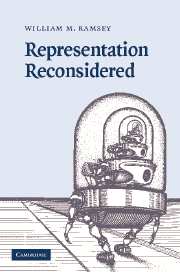Book contents
- Frontmatter
- Contents
- List of figures
- Preface
- 1 Demands on a representational theory
- 2 Representation in classical computational theories: the Standard Interpretation and its problems
- 3 Two notions of representation in the classical computational framework
- 4 The receptor notion and its problems
- 5 Tacit representation and its problems
- 6 Where is the representational paradigm headed?
- References
- Index
5 - Tacit representation and its problems
Published online by Cambridge University Press: 12 November 2009
- Frontmatter
- Contents
- List of figures
- Preface
- 1 Demands on a representational theory
- 2 Representation in classical computational theories: the Standard Interpretation and its problems
- 3 Two notions of representation in the classical computational framework
- 4 The receptor notion and its problems
- 5 Tacit representation and its problems
- 6 Where is the representational paradigm headed?
- References
- Index
Summary
In the last chapter we looked at one popular way of thinking about representation in many non-classical accounts of cognition, and saw how that notion of representation ran into serious difficulties. If I'm right, the receptor notion should be abandoned by cognitive scientists. While it may be beneficial to advance and adopt theories that posit internal relay structures, there is no explanatory benefit in viewing things that function in this manner as representations. Indeed, as we saw at the end of the last chapter, there are reasons to think that viewing them as representations leads to various theoretical problems. In this chapter, we will explore another, quite different family of representational notions that I will argue deserves a similar verdict. I'll refer to this family of representations as “tacit” representations. Because it involves a diverse range of structures, the tacit notion is not easily defined. Yet we can initially characterize it as based on the idea that there is a close link between the dispositional properties of a cognitive system, and a type of knowledge or information that the system represents “inexplicitly” or “tacitly.” This characterization may still seem vague, but it will hopefully become clearer as we progress. The tacit notion is not a new notion of representation, but it has gained considerable significance in recent years with the advent of various non-classical accounts of cognition, especially connectionism.
- Type
- Chapter
- Information
- Representation Reconsidered , pp. 151 - 187Publisher: Cambridge University PressPrint publication year: 2007



